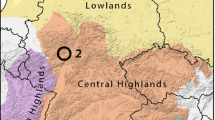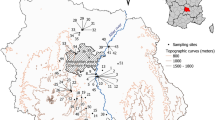Abstract
Springs are spatially restricted and insular ecotones. In the Alps, topography enhances this isolation. Springs are to a certain extent inhabited by organisms which are adapted to the relatively constant environmental conditions in springs. We examined thirty-six springs in eight different areas in the Swiss National Park (SNP) to understand if the macroinvertebrate assemblages of high-elevation springs are isolated or interconnected communities. We quantitatively and qualitatively sampled the macroinvertebrate assemblages of the springs and monitored environmental parameters. The similarity of the macroinvertebrate assemblages of the springs within and the dissimilarities between the different areas were relatively high; a clear spatial isolation was not evident. The differences of macroinvertebrate assemblages in different areas were explained by substrate parameters: springs in areas at lower altitudes were characterized by organic substrates and many water mite species. High-elevation springs were characterized by coarse inorganic substrates and Trichoptera of the genus Drusus. For spring conservation, it is important to decide on an individual basis if the loss of a single spring will have severe consequences for spring biodiversity.

© Data Swiss National Park


Similar content being viewed by others
References
Aubert, J., 1959. Plecoptera. Insecta Helvetica. Imprimerie La Concorde, Lausanne.
Bohonak, A. J. & D. G. Jenkins, 2003. Ecological and evolutionary significance of dispersal by freshwater invertebrates. Ecology Letters 6: 783–796.
Bonettini, A. M. & M. Cantonati, 1996. Macroinvertebrate assemblages of springs of the River Sarca catchment (Adamello-Brenta Regional Park, Trentino, Italy). Crunoecia 5: 71–78.
Cantonati, M., R. Gerecke & E. Bertuzzi, 2006. Springs of the Alps – sensitive ecosystems to environmental change: from biodiversity assessments to long-term studies. Hydrobiologia 562: 59–96.
Cantonati, M., L. Füreder, R. Gerecke, I. Jüttner & E. J. Cox, 2012. Crenic habitats, hotspots for freshwater biodiversity conservation: toward an understanding of their ecology. Freshwater Science 31: 463–480.
Clarke, K. R. & R. N. Gorley, 2006. PRIMER v6: user Manual. PRIMER-E, Plymouth.
Didham, R. K., T. J. Blakely, R. M. Ewers, T. R. Hitchings, J. B. Ward & M. J. Winterbourn, 2012. Horizontal and vertical structuring in the dispersal of adult aquatic insects in a fragmented landscape. Fundamental and Applied Limnology 180: 27–40.
Di Sabatino, A., R. Gerecke & P. Martin, 2000. The biology and ecology of lotic water mites (Hydrachnidia). Freshwater Biology 44: 47–62.
Di Sabatino, A., R. Gerecke, T. Gledhill & H. Smit, 2010. Chelicerata: Acari II. Spektrum Akademischer Verlag, Heidelberg.
Erman, N. A. & D. C. Erman, 1995. Spring permanence, Trichoptera species richness and the role of drought. Journal of the Kansas Entomological Society Supplement 68: 50–64.
Fischer, J., 1996. Kaltstenothermie – einziger Schlüssel zum Verständnis der Krenobionten? Crunoecia 5: 91–96.
Füreder, L., C. Schütz, M. Wallinger & R. Burger, 2001. Physico-chemistry and aquatic insects of a glacier-fed and a spring-fed alpine stream. Freshwater Biology 46: 1673–1690.
Geismar, J., P. Haase, C. Nowak, J. Sauer & S. U. Pauls, 2015. Local population genetic structure of the montane caddisfly Drusus discolor is driven by overland dispersal and spatial scaling. Freshwater Biology 60: 209–221.
Gerecke, R., 2003. Water mites of the genus Atractides Koch, 1837 (Acari: Parasitengona: Hygrobatidae) in the western Palaearctic region: a revision. Zoological Journal of the Linnean Society 138: 141–378.
Gerecke, R. & A. Di Sabatino, 1996. Water mites (Acari, Hydrachnellae) and spring typology in Sicily. Crunoecia 5: 35–42.
Gerecke, R. & H. Franz, 2006. Quellen im Nationalpark Berchtesgaden. Lebensgemeinschaften als Indikatoren des Klimawandels. Forschungsbericht 51. Nationalparkverwaltung Berchtesgaden.
Glöer, P., 2002. Die Süsswassergastropoden Nord- und Mitteleuropas. Die Tierwelt Deutschlands 73, ConchBooks, Hackenheim.
Hahn, H. J., 2000. Studies on classifying undisturbed springs in southwestern Germany by macrobenthic communities. Limnologica 30: 247–259.
Heino, J., 2013. Environmental heterogeneity, dispersal mode, and co-occurrence in stream macroinvertebrates. Ecology and Evolution 3: 344–355.
Heino, J. & J. Soinen, 2010. Are common species sufficient in describing turnover in aquatic metacommunities along environmental and spatial gradients? Limnology and Oceanography 55: 2397–2402.
Hering, D., A. Schmidt-Kloiber, J. Murphy, S. Lücke, C. Zamora-Munoz, M. J. López-Rodríguez & W. Graf, 2009. Potential impact of climate change on aquatic insects: a sensitivity analysis for European caddisflies (Trichoptera) based on distribution patterns and ecological preferences. Aquatic Sciences 71: 3–14.
Hoffsten, P.-O., 2004. Site-occupancy in relation to flight-morphology in caddisflies. Freshwater Biology 49: 810–817.
Ilmonen, J. & L. Paasivirta, 2005. Benthic macrocrustacean and insect assemblages in relation to spring habitat characteristics: patterns in abundance and diversity. Hydrobiologia 533: 99–113.
Kärna, O.-M., M. Grönroos, H. Antikainen, J. Hjort, J. Ilmonen, L. Paasivirta & J. Heino, 2015. Inferring the effects of potential dispersal routes on the metacommunity structure of stream insects: as the crow flies, as the fish swims or as the fox runs? Journal of Animal Ecology 84: 1342–1353.
Khan, A. & G. D. Rayner, 2003. Robustness to non-normality of common tests for the many-sample location problem. Journal of Applied Mathematics and Decision Sciences 7: 187–206.
Leibold, M. A., M. Holyoak, N. Mouquet, P. Amarasekare, J. M. Chase, M. F. Hoopes, R. D. Holt, J. B. Shurin, R. Law, D. Tilman, M. Loreau & A. Gonzalez, 2004. The metacommunity concept: a framework for multi-scale community ecology. Ecology letters 7: 601–613.
Lubini-Ferlin, V., P. Stucki, H. Vicentini & D. Küry, 2014. Ökologische Bewertung von Quell-Lebensräumen in der Schweiz. Entwurf für ein strukturelles und faunistisches Verfahren. Bericht im Auftrag des Bundesamtes für Umwelt (BAFU), Bern.
MacArthur, R. H. & E. O. Wilson, 1967. The theory of island biogeography. Princeton University Press, Princeton.
Maiolini, B., M. Carolli & L. Silveri, 2011. Ephemeroptera, Plecoptera and Trichoptera in springs in Trentino (south-eastern Alps). Journal of Limnology 70(Suppl. 1): 122–133.
Martin, P., 2004. Specificity of attachment sites of larval water mites (Hydrachnidia, Acari) on their insect hosts (Chironomidae, Diptera) – evidence from some stream-living species. Experimental and Applied Acarology 34: 95–112.
Martin, P. & E. Stur, 2006. Parasite-host association and live cycles of spring-living water mites (Hydrachnidia, Acari) from Luxembourg. Hydrobiologia 573: 17–37.
Martin, P., E. Stur & S. Wiedenburg, 2010. Larval parasitism of spring-dwelling alpine water mites (Hydrachnidia, Acari): a study with particular reference to chironomid hosts. Aquatic Ecology 44: 431–448.
Moog, O., 1995. Fauna Aquatica Austriaca. Wasserwirtschaftskataster, Bundesministerium für Land- und Forstwirtschaft, Wien.
Pauls, S. U., W. Graf, P. Haase, H. T. Lumbsch & J. Waringer, 2008. Grazers, shredders and filtering carnivores – the evolution of feeding ecology in Drusinae (Trichoptera: Limnephilidae): Insights from a molecular phylogeny. Molecular Phylogenetics and Evolution 46: 776–791.
Pickett, S. T. A. & P. S. White, 1985. The ecology of natural disturbance and patch dynamics. Academic Press, San Diego.
R Core Team 2014. R: A language and environment for statistical computing. R Foundation for Statistical Computing, Vienna, Austria. URL http://www.R-project.org/.
Schmedtje, U. & F. Kohmann, 1988. Bestimmungschlüssel für die Saprobier-DIN-Arten (Makroorganismen). Bayerisches Landesamt für Wasserwirtschaft, München.
Smith, B. P., 1988. Host-parasite interaction and impact of larval water mites on insects. Annual Review of Entomology 33: 487–507.
Sondermann, M., M. Gies, D. Hering, M. Schröder & C. K. Feld, 2015. Modelling the effect of in-stream and terrestrial barriers on the dispersal of aquatic insect species: a case study from a Central European mountain catchment. Fundamental and Applied Limnology 186: 99–115.
Studemann D., P. Landolt, M Sartori, D. Hefti & I. Tomka, 1992. Ephemeroptera. Insecta Helvetica. Imprimerie Mauron + Tinguely & Lachat SA, Fribourg.
Tachet, H., 2000. Invertébrés d’eau Douce. CNRS editions, Paris.
ter Braak, C. J. F. & P. Smilauer, 1998. CANOCO Reference Manual and User’s Guide to Canoco for Windows: software for Canonical Community Ordination (version 5). Microcomputer Power, Ithaca.
Townsend, C. R., 1989. The patch dynamics concept of stream community ecology. Journal of the North American Benthological Society 8: 36–50.
Trümpy, R., S. M. Schmid, P. Conti & N. Froitzheim, 1997. Erläuterungen zur Geologischen Karte 1:50000 des Schweizerischen Nationalparks. Geologische Spezialkarte Nr. 122, Vol. 87. Nationalpark-Forschung in der Schweiz, Zernez.
Van der Kamp, R. O., 1995. The hydrogeology of springs in relation to the biodiversity of spring fauna: a review. In: Ferrington, L. C. Jr. (ed.), Biodiversity of Aquatic Insects and Other Invertebrates in Springs. Journal of the Kansas Entomological Society 68: 4–17.
Von Fumetti, S., 2014. Naturnahe Quellen und ihre Lebensgemeinschaften – zehn Jahre Forschung im Röserental bei Liestal. Regio Basiliensis 55: 101–114.
Von Fumetti, S. & S. Felder, 2014. Faunistic Characterization of Alpine springs in the Swiss National Park. eco.mont 6: 23–29.
Von Fumetti, S. & P. Nagel, 2011. A first approach to a faunistic crenon typology based on functional feeding groups. Journal of Limnology Suppl 70(1): 147–154.
Von Fumetti, S., P. Nagel & B. Baltes, 2007. Where a springhead becomes a springbrook – a regional zonation of springs. Fundamental and Applied Limnology 169: 37–48.
Waringer, J. & W. Graf, 2011. Atlas der Mitteleuropäischen Köcherfliegenlarven. Erik Mauch Verlag, Dinkelscherben.
Waringer, J., W. Graf, S. U. Pauls, H. Vicentini & V. Lubini, 2008. DNA based association and description of the larval stage of Drusus melanchaetes McLachlan, 1876 (Trichoptera: Limnephilidae: Drusinae) with notes on ecology and zoogeography. Limnologica 38: 34–42.
Webb, D. W., M. J. Wetzel, P. C. Reed, L. R. Philippe & T. C. Young, 1998. The macroinvertebrate biodiversity, water quality, and hydrogeology of ten karst springs in the Salem Plateau of Illinois. In Botosaneanu, L. (ed.), Studies in crenobiology: the biology of springs and springbrooks. Backhuys Publishers, Leiden: 39–48.
Weixlbaumer, N., D. Siegrist, I. Mose & T. Hammer, 2015. Participation and regional governance. A crucial research perspective on protected areas policies in Austria and Switzerland. In Gambino, R. & A. Peano (eds), Nature Policies and Landscape Policies. Springer, Berlin: 207–215.
Wigger, F. W., L. Schmidlin, P. Nagel & S. von Fumetti, 2015. Macroinvertebrate assemblages of natural springs along an altitudinal gradient in the Bernese Alps, Switzerland. Annales de Limnologie 51: 237–247.
Woodward, G., D. M. Perkins & L. E. Brown, 2010. Climate change and freshwater ecosystems: impacts across multiple levels of organization. Philosophical Transactions of the Royal Society B 365: 2093–2106.
Acknowledgements
We acknowledge numerous people who helped with the fieldwork. Thanks to Lukas Forlin, Susanne Felder and Lisette Kaufmann for providing their data. We thank Peter Martin for identifying the Acari and Verena Lubini for verifying the EPT-Taxa. Many thanks also to the Swiss National Park for logistic advice and information on the springs, in particular R. Haller and C. Schlüchter. Thanks are owed to the Swiss Acadamy of Sciences for some financial support. We also thank Lara Schmidlin, who improved the English and made helpful comments on the manuscript, and two anonymous reviewers, who further helped to improve the manuscript.
Author information
Authors and Affiliations
Corresponding author
Additional information
Guest editors: Mary Kelly-Quinn, Jeremy Biggs & Stefanie von Fumetti / The Importance of Small Water Bodies: Insights from Research
Electronic supplementary material
Below is the link to the electronic supplementary material.
Rights and permissions
About this article
Cite this article
von Fumetti, S., Blattner, L. Faunistic assemblages of natural springs in different areas in the Swiss National Park: a small-scale comparison. Hydrobiologia 793, 175–184 (2017). https://doi.org/10.1007/s10750-016-2788-5
Received:
Revised:
Accepted:
Published:
Issue Date:
DOI: https://doi.org/10.1007/s10750-016-2788-5




